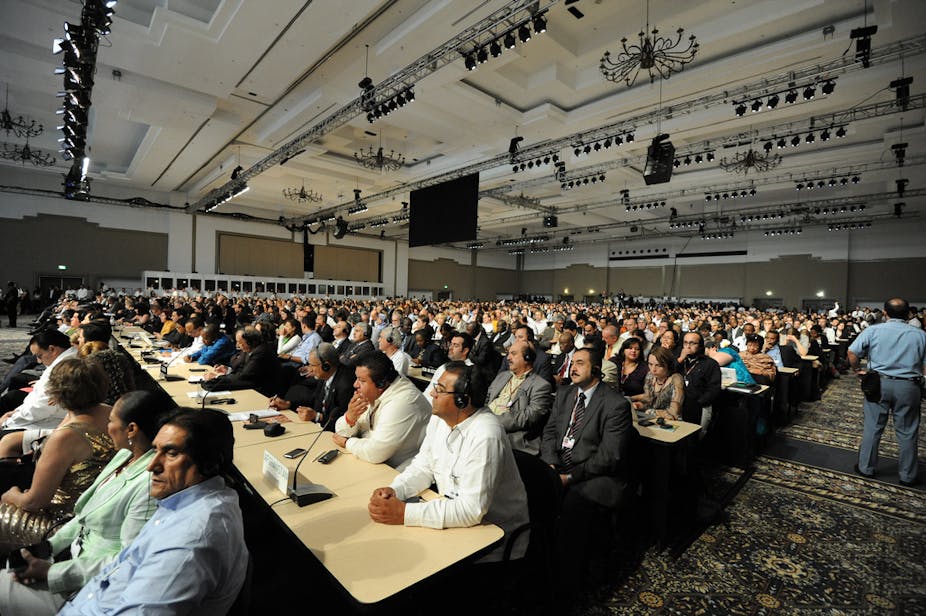The idiosyncratic nature of pledges by countries to stem their greenhouse gas emissions is an indicator of the chaos that characterises international climate change policy.
The countries that have quantified their cuts do so by different quantities and against different baselines. Other countries pledge, instead, to reduce their emissions intensity (the amount they emit per unit of gross domestic product) but at different rates over different periods.
It is impossible for citizens of a country to see how their country’s target compares with other countries, or with what is required to stem global warming, because comparisons can’t be made without detailed analysis.
The table below shows the four largest emitters’ official national pledges to reduce greenhouse emissions. Together, they release 68% of the global emissions total. These pledges are compared with Australia’s commitment to reduce 2020 emissions by 5% against 2000 levels, and also with a 25% cut.

You can see that Australia’s 5% effort is weak against the emissions cuts of the US and Russia. But translated to emissions intensity, it is on a par with China’s effort and far superior to India’s.
The quantification of cuts has been strenuously opposed by China and India, because their emission levels are strongly correlated with economic growth. Their seemingly respectable cuts in emission intensity are designed to minimise economic impacts.
The burden of reductions is thus not being shared equitably across the large emitters. While it can be argued that China and India are developing and therefore should be allowed soft pledges, the fact is that containing global warming requires substantial efforts by all large emitters.
While Australia is not among the large emitters, there are compelling reasons that it should shoulder a fairer share of the burden and pledge a 25% cut. Australia:
has one of the highest level per capita emissions in the world
is an emissions-intense economy with plenty of room to improve
is one of the richest countries and can afford to adjust its economy.
If Australia were to take up the challenge of a 25% cut, a concentrated effort would be needed to accelerate the rate of decarbonisation of its economy. This would require the implementation of strong policies.
But the irony is that the new Liberal-National government is busy reducing its policy options. It is about to ditch the most powerful tool in its box – a progressive carbon price. This will be replaced by the Direct Action Plan, the efficiency and effectiveness of which - as former treasury secretary Ken Henry underlined this week - is in doubt.
Furthermore the new government, under heavy lobbying pressure, is threatening the Renewable Energy Target. This scheme has contributed to the adoption of wind and solar and been partly responsible for a reduction in the growth of Australia’s emissions.
Renewables must be supported to make up an increasing component of the energy mix if Australia is to progressively decarbonise its economy along with the rest of the world.
The world’s economy will need to be virtually decarbonised by 2050 to stay within the carbon budget and have a good chance of limiting temperature rise to 2C. The earlier the hard decisions are made the less costly the adjustment will be in economic terms.
Dismayingly, and as a further manifestation of chaos in international climate change policy, concerted international action has been postponed to 2020. In the absence of any catalyst, countries have no incentive to improve on their performance over the next seven years and profligate use of the precious carbon budget will thus continue.
But what are the prospects that in 2020 a comprehensive internationally binding agreement will be struck? Barriers to coordinated action are no different to what they were at the failed 2009 Copenhagen conference. Countries can’t be forced to adopt binding targets; and the integrity of an agreement is destroyed by the defection of only one or two large emitters. This was illustrated in the case of the Kyoto Protocol, doomed from the start because it didn’t cover the world’s two largest emitters, China and the US.
Upcoming climate meetings such as next week’s in Warsaw won’t alter the 2020 timetable and can’t remove the barriers.
Countervailing the pessimism pervading climate policy is a cause for optimism. That is that the market will play an accelerating and very important role, greatly facilitating the transition to a low carbon economy. Technology is continually improving the benefit-cost ratio of solar power. Even if we can’t manage to legislate for a sustainable future, perhaps we will find investing in the solar revolution irresistible.

